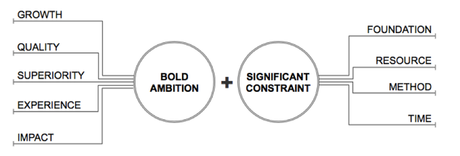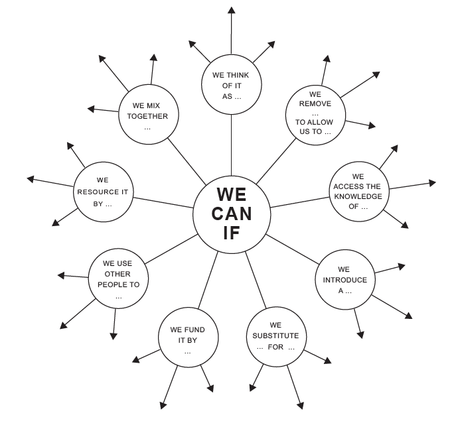In an earlier post in the series "21st Century Challenges" about Who Owns Your Medical Data? we discussed the following:
In the future, Big Data algorithms and biometric sensors may detect and diagnose a disease before we have started to notice any discomfort or signs. But would you like your insurance company to tell you to stop eating x or y because according to the algorithm it might lead to the development of a disease in the future?
How to regulate the ownership of medical data in law and with the help of technology?
We ended up with four Idea Sensitive Points. After assessing them against impact and effort, we chose the following as a point of departure for a next idea generation session:

The current frameworks about ownership (legislation, technology) are developed for physical objects and not for re-usable and resale data. We could speak of a blocked or stagnant situation in law and technology. There seem to be no new ideas, we cannot find a way forward. Could we modify the Creative Commons licence? Could we apply the principles underlying quantum computing to innovate data protection? It may be worth to spend some fresh thinking, starting again.
Planning the Thinking
The Focus

Now we have defined the subject: about what we are going to think about. We also have the aim of our thinking effort:
How to regulate the ownership of medical data in law and with the help of technology.The next steps we have to proceed before our actual thinking starts are:
- Redefine the problem in at least 15 ways
- Choose an obvious one or an exotic one
- Make the question more challenging
- Formulate the Propelling Question by adding a constraint
- Formulate the selection criteria for assessing ideas
Redefine the problem in at least 15 ways
Reformulate the problem in at least 15 ways. The problem here is..., and also..... and at the same time also... Avoid formulating problems too narrow, because then the problem will just be a concrete solution and will not give you a direction for further searching for new ideas.
Our attempt: the problem is... and also... and at the same time...- A doctor uses data for making a diagnosis, a creative act, so she owns Intellectual Property Rights, but a patient pays a GP for making a creative effort, for that he lets the GP measure his condition; at that way, he is still the (co-) owner and has IPR's.
- There are private health insurances and even if you pay for your medical treatments the State still has the right to obtain medical data.
- To protect medical data from being used in a way that I do not like.
- The availability of personal medical data undermines the concept of solidarity in health care. Traditional health insurance spreads the risk for an individual patient over a large number of persons; the premiums are based on the average occurrence of an illness in a large group. Advanced personal data, however, will make it possible to exactly calculate individual risks, and ditto the premium to be paid. Premiums will be individualized: people with a predisposition to illness pay lifelong more.
- I might change my mind and would like to share my medical information if I discover that I am suffering from a certain illness or has a great risk for developing a serious illness.
- The same as with music rights?
- Medical data collected are only valuable if they are linked to personal information, for example, environmental data related to air pollution.
- Correlations between factors do not equal causation and other data might be collected without our consent.
- Privacy is treated as an either/or permission
- There is no need to share certain data, we could become our own doctors and cure certain illnesses without the involvement of medical professionals.
Then, choose one problem definition from your list that either leads to an immediate practical idea or one that is so exotic that you can't imagine how you ever can construct a sane idea for it. For sure, that's the way breakthrough ideas are generally created. But admittedly, that requires very hard work.
- Make the concept of Creative Commons Licences suitable for medical data and informational products
- Regulate medical data like Apple did with music rights by the concept of iTunes
- Perhaps a combination: you can trade personal medical data to different companies, research projects, universities, assurance companies, patient associations against different prices. You can also refuse to make medical data available for certain goals or companies.
- Royalty free medical data that can be downloaded on your own website for free and companies can also buy some data.
- You always have the copyright of your own data but companies can download it.
- Your GP/doctor can act as a manager and make sure suitable companies get access, you always have to approve before it is sent or sold.
It is important to write down emergent or even embryonal ideas before you forget them.
Make the question more challenging
Later on, we will evaluate all them together with the breakthrough idea that we try to create out of the most exciting problem definition.
Our attempts:- There are many producers of medical information (data, diagnoses, prediction, research papers, medication consumption, lifestyle indicators, environmental factors) that can be misused by the State, companies, employers, insurers, family and the medical institutions themselves
Then make the challenge less boring and sexier. That is: make them more imaginative, outreaching, challenging, interesting or radiating a bold ambition
In What Ways Might We radically make impossible stalking with medical data and information.
Note that we changed from a problem orientation to an action orientation, by using the phrase In What Ways Might We ...
Our attempt:The Propelling Question
Finally, construct a propelling question that has a contradiction in it. A propelling question is one that drives forward the effort for creative thinking by using a bold ambition and a significant restriction.

IWWMW make medical stalking radically impossible while at the same time all data on a world scale becomes available for personalized medicine.
Our attempt:Formulate the selection criteria for assessing ideas
Setting criteria against ideas at the end of a session will be evaluated is a very useful way to reflect beforehand on possible outcomes. It will prevent " drifting", that is coming up with wild and great ideas that are not relevant for this particular thinking task. Another advantage to set criteria before actually generating ideas is that it prevents a certain bias against crazy ideas, i.e. ideas that are not well-suited for overcoming the challenge.
- Effect - to what extent is the propelling question resolved? Scale 1 - 5
- Acceptability - the degree of acceptance by medical professionals. Scale 1 - 5
Now we have quite a direction about what kind of outcomes we are striving for. What creative thinking technique might be fruitful?
Our attempt:

- Working backwards from an Ideal Final Result
- Identifying the current dominant thinking and then escape from it
- Set up a Provocative Operation and move forward to a practical idea
- Complete the sentence: "We Can IF..."
We will use the phrase We Can IF looking at different directions; designing at least three possibilities per direction.
Execution
Choose a creative thinking technique and spend 2 to 10 minutes to arrive at a practical idea. If you have no results after this time, don't try longer. Maybe you are just circling in rounds. Try the next day or choose another creative thinking tool.
